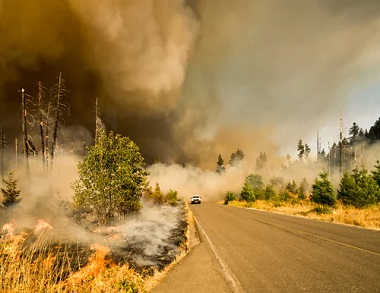“Burn-boss†arrested
Last week Oregon was being hailed for another first. News outlets were claiming the arrest of federal government firefighter Rick Snodgrass at a fire on October 19 for conducting their assigned duties was a first. In a prescribed burn of a 300-acre thick underbrush in the Malheur National Forest, the fire jumped a containment line and burned an unintended 18 to 20 acres of adjacent private land.
Grant County Sheriff Todd McKinley told “Wildfire Today†that when the Malheur National Forest’s Star 6 prescribed fire escaped control and spread onto the privately owned Holliday Ranch, the ranch employees were actually out helping them try to catch the fire and prevent it from doing more damage. But at the same time some of them were “highly upset.â€
Two sisters from the family-owned Windy Point Cattle Co. confronted the Forest Service's "burn boss," Ricky Snodgrass, on why they were burning and then dialed 911. The Grant County sheriff arrived and placed Snodgrass under arrest for a reckless burn. He was later granted conditional release from custody pending further investigation.
In his interview, Sheriff McKinley said the next step is “getting to the bottom of why they were even burning to begin with and why they chose to burn at that time. You know, there’s a lot more to this. Everybody knew it was a bad burn, should not be happening. Even the fire staff out there, there are fire personnel that were on scene that are afraid to say much because, you know, their jobs. It was not the right time to burn and there may have even been means taken to get that burn done that were outside the scope. That’s kind of where it’s at. You know, it’s a really tenuous situation and more details will come out.â€
The recognition of the unintentional burn by the US Forest Service has been one of avoidance. On Twitter they acknowledged the escape but said it was caught within an hour, and failed to mention the arrest. The Forest Service chief and regional director has been supportive of the employees carrying out their official duties as federal employees. However, there is no acknowledgement of the loss to ranchers as a “good neighbor†would.
A D V E R T I S E M E N T

A D V E R T I S E M E N T
Tonna Holliday, one of the sisters, who lost about 20 acres of timber and grassland, illuded to a conflict between private landowners and federal land managers in eastern Oregon has been simmering for years. In Grant County the U.S. government manages around 60 percent of the land. When the first burn started six days prior to leaping the boundaries, she said they spoke with Snodgrass about the burn consuming fences on federal land that they are responsible for maintaining and showed signs of jumping the highway. For her, somebody needed to be accountable.
The Good Neighbor Authority Agreement was first passed in 2016 as a step for Oregon to enter into cooperative agreements with the U.S. Forest Service allowing the state to perform forest management and watershed restoration services on National Forest lands. Jeff Burns, Program Director, said in 2021 that 92-93 percent of all wildfires were on federal lands, which accounts for 60 percent of forested lands in Oregon. Burns reported, since 2016, significant progress had been made in wildfire risk reduction on federal lands through fuels reduction and forest thinning projects. He said, “Any efforts to reduce wildfire risks in Oregon, must involve federal lands in a meaningful way.â€
The U.S. Forest Service adopted a plan earlier this year to step up prescribed burns, and aggressively thin forest stands with strategic logging programs. Local conflict with federal land management policies, including logging restrictions, has contributed to a decline in timber production and sawmills. Locals are in agreement with reduction of wildfire risks, but being inflexible to local concerns does not seem to be what the Good Neighbor Authority means by cooperation.
--Donna Bleiler| Post Date: 2022-11-02 14:38:31 | Last Update: 2022-11-02 15:03:09 |







